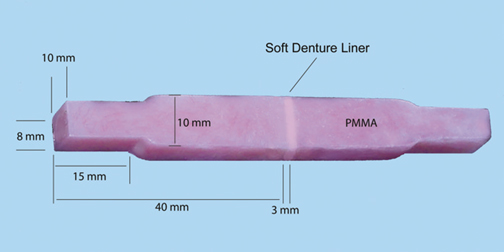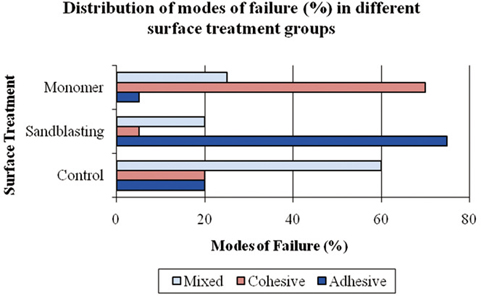J Adv Prosthodont.
2011 Mar;3(1):16-19. 10.4047/jap.2011.3.1.16.
The effect of denture base surface pretreatments on bond strengths of two long term resilient liners
- Affiliations
-
- 1Department of Prosthodontics, Government Dental College & Hospital, Nagpur, Maharashtra, India. drrahulprostho@yahoo.com
- KMID: 1975109
- DOI: http://doi.org/10.4047/jap.2011.3.1.16
Abstract
- PURPOSE
Purpose of this study was to evaluate effect of two surface treatments, sandblasting and monomer treatment, on tensile bond strength between two long term resilient liners and poly (methyl methacrylate) denture base resin.
MATERIALS AND METHODS
Two resilient liners Super-Soft and Molloplast-B were selected.Sixty acrylic resin (Trevalon) specimens with cross sectional area of 10x10 mm were prepared and divided into two groups of 30 specimens each. Each group was surface treated (n = 10) by sandblasting (250 micro alumina particles), monomer treatment (for 180 sec) and control (no surface treatment). Resilient liners were processed between 2 poly(methyl methacrylate) surfaces, in the dimensions of 10x10x3 mm. Tensile strength was determined with Instron Universal testing machine, at a crosshead speed of 5 mm/min; and the modes of failure (adhesive, cohesive or mixed) were recorded. The data were analyzed using one-way ANOVA, followed by Tukey HSD test (alpha = 0.05).
RESULTS
Monomer pretreatment of acrylic resin produced significantly higher bond strengths when compared to sandblasting and control for both resilient liners (P < .001). Sandblasting significantly decreased the bond strength for both the liners when compared to monomer pretreatment and control (P < .001). Mean bond strength of Super-Soft lined specimens was significantly higher than Molloplast-B in various surface treatment groups (P < .05).
CONCLUSION
Surface pretreatment of the acrylic resin with monomer prior to resilient liner application is an effective method to increase bond strength between the base and soft liner. Sandblasting, on the contrary, is not recommended as it weakens the bond between the two.
Keyword
MeSH Terms
Figure
Reference
-
1. Anusavice KJ. Phillips' science of dental materials. 2003. 11th ed. Saunders: Elsevier;750–751.2. Sarac D, Sarac YS, Basoglu T, Yapici O, Yuzbasioglu E. The evaluation of microleakage and bond strength of a silicone-based resilient liner following denture base surface pretreatment. J Prosthet Dent. 2006. 95:143–151.3. Emmer TJ Jr, Emmer TJ Sr, Vaidynathan J, Vaidynathan TK. Bond strength of permanent soft denture liners bonded to the denture base. J Prosthet Dent. 1995. 74:595–601.4. El-Hadary A, Drummond JL. Comparative study of water sorption, solubility, and tensile bond strength of two soft lining materials. J Prosthet Dent. 2000. 83:356–361.5. Jacobsen NL, Mitchell DL, Johnson DL, Holt RA. Lased and sandblasted denture base surface preparations affecting resilient liner bonding. J Prosthet Dent. 1997. 78:153–158.6. Saraç YS, Başoğlu T, Ceylan GK, Saraç D, Yapici O. Effect of denture base surface pretreatment on microleakage of a silicone-based resilient liner. J Prosthet Dent. 2004. 92:283–287.7. al-Athel MS, Jagger RG. Effect of test method on the bond strength of a silicone resilient denture lining material. J Prosthet Dent. 1996. 76:535–540.8. Kawano F, Dootz ER, Koran A 3rd, Craig RG. Comparison of bond strength of six soft denture liners to denture base resin. J Prosthet Dent. 1992. 68:368–371.9. Bates JF, Smith DC. Evaluation of indirect resilient liners for dentures: Laboratory and clinical tests. J Am Dent Assoc. 1965. 70:344–353.10. Kulak-Ozkan Y, Sertgoz A, Gedik H. Effect of thermocycling on tensile bond strength of six silicone-based, resilient denture liners. J Prosthet Dent. 2003. 89:303–310.11. Craig RG, Gibbons P. Properties of resilient denture liners. J Am Dent Assoc. 1961. 63:382–390.12. Amin WM, Fletcher AM, Ritchie GM. The nature of the interface between polymethyl methacrylate denture base materials and soft lining materials. J Dent. 1981. 9:336–346.13. Brown D. Resilient soft liners and tissue conditioners. Br Dent J. 1988. 164:357–360.14. Kawano F, Dootz ER, Koran A 3rd, Craig RG. Bond strength of six soft denture liners processed against polymerized and unpolymerized poly(methyl methacrylate). Int J Prosthodont. 1997. 10:178–182.15. Al-Athel MS, Jagger RG, Jerolimov V. Bone strength of resilient lining materials to various denture base resins. Int J Prosthodont. 1996. 9:167–170.16. Kutay O. Comparison of tensile and peel bond strengths of resilient liners. J Prosthet Dent. 1994. 71:525–531.17. Khan Z, Martin J, Collard S. Adhesion characteristics of visible light-cured denture base material bonded to resilient lining materials. J Prosthet Dent. 1989. 62:196–200.18. Dootz ER, Koran A, Craig RG. Physical property comparison of 11 soft denture lining materials as a function of accelerated aging. J Prosthet Dent. 1993. 69:114–119.19. Vallittu PK, Lassila VP, Lappalainen R. Wetting the repair surface with methyl methacrylate affects the transverse strength of repaired heat-polymerized resin. J Prosthet Dent. 1994. 72:639–643.
- Full Text Links
- Actions
-
Cited
- CITED
-
- Close
- Share
- Similar articles
-
- Effect of denture base surface pretreatments on the tensile bond strength between a resilient liner and a processed denture base resin
- Investigation of bonding properties of denture bases to silicone-based soft denture liner immersed in isobutyl methacrylate and 2-hydroxyethyl methacrylate
- A study on the bonding strength of resilient denture liners
- COMPARISON ON TENSILE BOND STRENGTH OF PERMANENT SOFT DENTURE LINERS BONDED TO THE DENTURE BASE RESIN
- Effect of surface design on bond strength of relining denture resin



